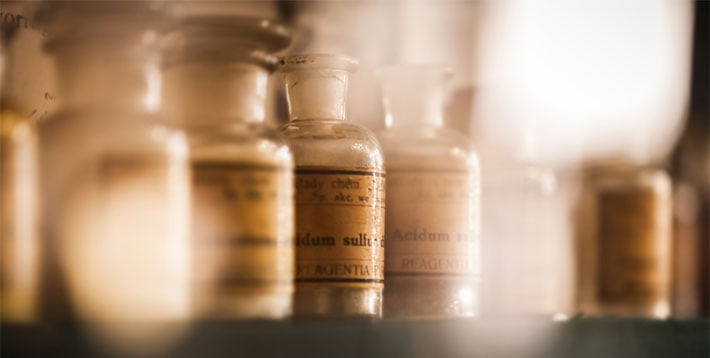Why is it important to have a written compounding compliance program?

Compounding Medications
Prior to the 1940s, nearly all prescription medications were compounded. With the increased demand for mass manufacturing of drugs after World War II, the number of compounded medications quickly dwindled. Unfortunately, this led many patients to not have all their needs met. Luckily today, many community pharmacies are able to compound medications to help personalize medications for patients who need alternate strengths, dosage forms, flavors and even alter ingredients because of allergies or sensitivities.
Today’s pharmacies have a myriad of agencies looking at their compounding practices:
- USP (U.S. Pharmacopeia Convention) establishes guidelines for definitions and standards for every aspect of compounding, and they are all changing in December 2019
- State Boards of Pharmacies are beginning to establish regulations for the control and handling of compounded pharmaceuticals
- Food and Drug Administration (FDA) establishes guidelines and often conducts surveillance inspections with the State Board inspections
- State Environmental Agencies are also coming into the pharmacies to review the processes for handling Hazardous Drugs under USP <800> and their disposal
This can be slightly overwhelming and nerve-racking to determine what compliance items you actually need to have in place. If that wasn’t hard enough, now some of the Pharmacy Benefit Managers (PBMs) are requiring pharmacies submit compounding policies and procedures during their credentialing and attestations.
In this article, we will discuss why having a compounding compliance program is important, things you can do to get started, examples of other people who thought they didn’t need to have written compounding items in place and the issues they got into, some solutions to help you determine if compounding is right for you and the items you should have in place.
In short, establishing a compounding compliance program shows a pharmacy is committed to implementing and following high levels of standards for the quality of products produced and the safety of their patients. Referencing USP <1075> “Good Compounding Practices” is a great place to start if you are interested in starting your own compounding program. Items to call special attention to are:
- Responsibilities of the Compounder
- Drug Compounding Equipment
- Labeling
- Training
- Component Selection Requirements
- Drug Compounding Facilities
- Procedures and Documentation
- Records and Reporting
- Compounding for a Prescriber’s Office Use
- Compounding for Veterinarian Products
- Packing and Drug Preparation Containers
- Compounding Controls
No matter who is looking at your compounding process, small or large, there is one consistent item. The pharmacy must have policies and procedures in place for the operation of any and all compounding operations. In addition, Standard Operating Procedures (SOPs) must be established for equipment and other pharmacy specific processes. Most SOPs are simply taking the owner’s/operator’s manual of the mixer, stirrer, hood, scale, etc., and writing on the front cover, SOP and adding a number. You never want to re-write an owner’s manual. Another SOP is how you prepare to do a compound as an example.
All Pharmacy Benefit Managers (PBMs) require pharmacies to have and maintain a Continuous Quality Improvement (CQI) program. This is a Medicare Part D requirement. However, if the PBM requires a CQI certificate, the only way this can be accomplished is by working through a Patient Safety Organization (PSO). PSOs provide a unique role in healthcare and especially in pharmacy. First, they establish a training and reporting requirement for Quality Related Events (QREs) formerly known as Adverse Events. When the pharmacy completes the training and begins the weekly reporting requirements, the CQI certificate becomes available, and the pharmacy can submit the certificate to the PBM, satisfying this requirement. The PSO also establishes protected processes when a QRE occurs. A QRE is when the patient receives the wrong medication or has a reaction to the medication whether it was the fault of the pharmacy or not. The protection comes by the way of setting up an area called a Patient Safety Evaluation System. Certain documents and conversation fall under a “privilege” area, but very strict requirements must be maintained and followed through this process.

This Can Happen to Anyone at Anytime
By now you’re probably wondering “What’s the worst case scenario if you don’t have a compounding program in place?” Should an adverse event occur, which you’ve seen them on the news, for example, a patient received a compound with the wrong ingredients, one of the ingredients was the wrong dose or maybe a patient received the wrong compound all together, and your patient is in the hospital emergency room receiving treatment.
- You may not know about the event
- If there are more than three people arriving to the ER, the ER protocol is to contact the Centers for Disease Control and Prevention (CDC)
- If the number of people arriving to the ER continues to grow, the ER communication with the CDC is constant. The CDC and the ER try to find the common denominator of the source of event
- The CDC contacts the Food and Drug Administration who arrive at the hospital and start interviewing patients
- The State Pharmacy Board is contacted
- The pharmacy opens the next morning, and business is normal until the CDC, FDA and the State Board walk in.
The question is, what do you do? Not only do you have to deal with these governmental agencies demanding answers to questions about your operations, policies and procedures and records, but they just told you your patients, your friends are in the hospital because of an event which is leading back to your pharmacy.
Okay, you are thinking, this is just another sterile compounding pharmacy not following protocols. Actually, every time we have encountered this scenario, it has been top of the line independent pharmacies doing non-sterile compounds.
At this point, there are several important items that come into play. First is your liability insurance carrier. This is one area you don’t want to go cheap on. The best insurance carrier we have worked with by far is Pharmacist Mutual. You call them and explain the incident. They ask what hospital the patients are being treated at and if you are working with a Patient Safety Organization (PSO) and which one. Pharmacist Mutual contacts the hospital and provides a claim number, and all claims are charged to that claim number. Pharmacist Mutual then asks for the final report from the Patient Safety Report.
If you don’t have a PSO, then Pharmacist Mutual and all other liability insurance carriers will be asking for the pharmacy’s policy and procedure manual. Compounding first, then pharmacy operations and then 100% of all policies and procedures and SOPs. The preparation for a lawsuit is quite different when a PSO is not involved.
Some Examples of Lawsuits
Most people are familiar with the 2012 compounding tragedy in Massachusetts that led to over 14,000 patients receiving contaminated injections, of which 750 patients developing fungal infections that caused the deaths of more than 60 patients.
According to the CDC, in March 2012, 33 patients in seven states developed fungal eye infections after surgery in which they were injected with contaminated drugs prepared by a compounding pharmacy in Florida. Three-fourths of the patients suffered vision loss, some severe; 80% required additional surgery.
In March 2011, nine patients died in six Alabama hospitals after receiving contaminated nutritional supplements prepared by a compounding pharmacy in Birmingham according to an investigation by the state health department and the CDC. The outbreak was traced to contaminated water used in the product.
In March 2007, two patients in Washington and Oregon died after getting doses of an intravenous pain medication that was measured improperly by a compounding pharmacy in Texas the CDC reported. A third patient in Oregon also died, "likely associated with the same compounding error," the report said.
In September 2005, three patients died and several others were sickened at a Virginia hospital after receiving drugs made at a compounding pharmacy in Maryland according to a state pharmacy board investigation. The drugs, shipped to three states and Washington, D.C., were recalled after the FDA found contamination in remaining samples.
What to Prepare for in 2019
While these instances all occurred in sterile compounding settings, which have very strict and stringent requirements including accreditation, those participating in non-sterile compounding can still learn from their mistakes.
Currently there is a lot of “buzz” around USP <800> “Hazardous Drugs”. It’s already been delayed once and is being rewritten to coincide with USP <797> with a release date of June 15, 2019, and an effective date of December 1, 2019. The “hood” is our main topic. Many facilities and organizations are already fretting about the high costs of these hoods that are normally required for sterile compounding that will now be imposed on all practices including those doing non-sterile compounding.
As this guideline goes into effect, it also opens Pandora’s Box to pharmacies, changing the structure of their building to install the hood. Pharmacies that were grandfathered by implementing the Americans with Disabilities Act (ADA) will now have to make all other improvements to bring their building up to current building code. Depending on the age of the building, the location of the building and the type of hood the pharmacy wishes to install (non-sterile and/or sterile), this upgrade can go from $10,000 to $150,000 in a flash.
The Solution
If your state and/or insurance company requires you to have written Policies & Procedures, the R.J. Hedges Compounding Program meets the current USP requirements and will be amended as needed once the new guidelines are published. Don’t worry, all those items mentioned earlier from USP <1075> are all included in our Compounding Program that has over 40 Policies & Procedures and dozens of support documents with more coming as USP <795>, <1075> and <800> come on line. In addition, our clients are automatically enrolled in the APMS PQC+ Program!
So you may be asking, is it really worth doing compounding if all these regulations and costs are going to get factored in? Our best answer is maybe. As of today, a lot of insurance companies still are not paying for compounds, leaving patients to pay a cash price; OptumRx is paying for a few, and Medicare is still not paying. If you are currently preparing compounds and you’d like to see how your pharmacy is doing compliance-wise, complete our free Compounding Assessment.
Video: Full Transcript
Why is it important to have a written Compounding Compliance Program?
Jenny Schell Sr. Compliance Strategist
Compounding is controlled by both the state and federal governments with USP 795 providing the frame work.
Currently the buzz is all around the USP 800- dangerous drugs. It’s already been delayed once and the UPS is rewriting USP 800 to coincide with USP 797 with a tentative release date of December 1, 2019.
Most states are already requiring some form of compounding regulation for viable P&P’s for non-sterile compounding, but not accreditation. The policies and procedures must be written for the current USP 795 and USP 1075 guidelines. Granted this may change once the USP releases the new guidelines in 2019.
Our Policies and procedures meet the current requirements and will be amended as needed once the new guidelines are published. The RJHedges Compounding Program outlines the responsibility for the Pharmacist, Compounder, the PIC and the Compounding Tech and has policies for setting up a compounding program, lab and process for compounding. It also includes requirements for Labeling, Packaging, Formulary and Documentation. We have taken a seemingly difficult topic and given you a very simple process to comply with USP in your Pharmacy..

